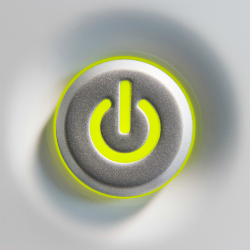
The issue of 'standby power' is not new. I think I first heard about it sometime in college or maybe when flat screen TV’s started getting cheaper. A quick Google search yields about 12 million results on the topic. Standby power is basically the secret energy that electronic devices consume when you’re not looking to stay ready for your next use. The biggest culprits seem to be TV’s, DVR’s, computers, cell phone chargers, refrigerators, and heating/cooling systems. A device with a continuous light or display, such as an alarm clock, is a dead giveaway of standby power draw. The US Department of Energy estimates that simply setting a computer to sleep mode may save $100 a year.
Thus, the statistician and cheapskate in me could not help but delve into an exciting experiment of my own. How much could I save on my monthly electricity bill by simply doing a little unplugging and being smarter about my use?
My journey began with logging onto my electricity account and investigating my usage and costs. Tables, pie charts, and daily use and costs were available at my fingertips. I chose the first week of October as my starting point to reduce major air conditioning costs associated with the insanely hot summers in Texas that might bias my results. During that week, my energy consumption was 99.2 kilowatt hours (kWh) at a cost of roughly $15. I’d assumed that most of my usage would naturally come from the refrigerator and occasional air conditioning at night, but was surprised to find these accounted for only 7.1 and 35.6 kWh, respectively. Over 50% of my usage was coming from other mysterious sources.
An extensive inventory of my single bedroom, 706 square foot 1980’s apartment yielded the following suspects: 60 watt light bulbs in my ceiling fan and closets, a flat screen TV and blu-ray player, small microwave, desktop computer and accessories, laptop and accessories, alarm clocks, iPod players and nightly cell phone charging. With just a few simple steps, I swapped out my 60W bulbs for 13W CFL’s, got power strips for my electronics, and started charging my cell phone in the car. I didn’t go as far as getting a refrigerator timer, but I did adjust the temperature settings by one number and now try to keep my freezer full.
The largest source of my unnecessary power usage was undoubtedly the 24/7 running of both a neglected desktop computer and a laptop that only gets used once a week. Estimating my desktop computer and monitor alone to use approximately 100-200W per hour this would translate to 2.4-4.8 kWh per day, using the given formula for a kilowatt-hour defined by (Watts X Hours Used)/1000. With my current electricity plan costing 8.9₵ per kWh with a $9.45 monthly base charge and 3.49₵ surcharge per kWh, my desktop computer costs alone were likely $18-27 per month.
Post-experiment, my weekly energy consumption is about now 40 kWh per week, a reduction of almost 60kWh per week or $30 a month from my starting point. When I’m away from home with nothing but the refrigerator running, my energy cost is $0.55/day. Even when I am home, my costs are still usually less than $1 a day.
For a few other examples closer to your heart, search online and do the math yourself. Many electricity companies now offer smart meters and online tools, and home meters are available for self-purchase if you’re up for some Sherlock Holmes investigating of your own. All you need to know is the number of watts your appliance uses, the number of hours you use it a day, and how much you pay per kilowatt-hour.
For example, if the average cell phone uses 2.24 watts when fully charged and you decide to keep it plugged in when already 100% charged all night for 8 hours, you would use (2.24*8)/1000 or 0.018 kWh per night, 0.13 kWh per week, or only 6.5 kWh per year. At the 2013 US residential average of 12.16₵ per kWh, 6.5 kWh per year costs less than $1, or 0.1216*6.5=$0.79 to be exact. It doesn’t add up to much based on your phone alone. However, if the entire US population over the age of 18 did the same thing for a year it’d result in over 1.5 billion kWh, likely a drastic overestimation but you see the point. Energy from multiple sources and people add up quickly.
In the economical world of the extreme cheapskates, many people go further than just reducing electricity costs. In their eyes, all aspects of our lifestyle are subject to cost cutting, from using second hand clothes, doing laundry in the shower to finding treasures in the trash. I didn’t go as far as dumpster diving for this article, but you never know, my next inspiration is out there waiting for me somewhere.




